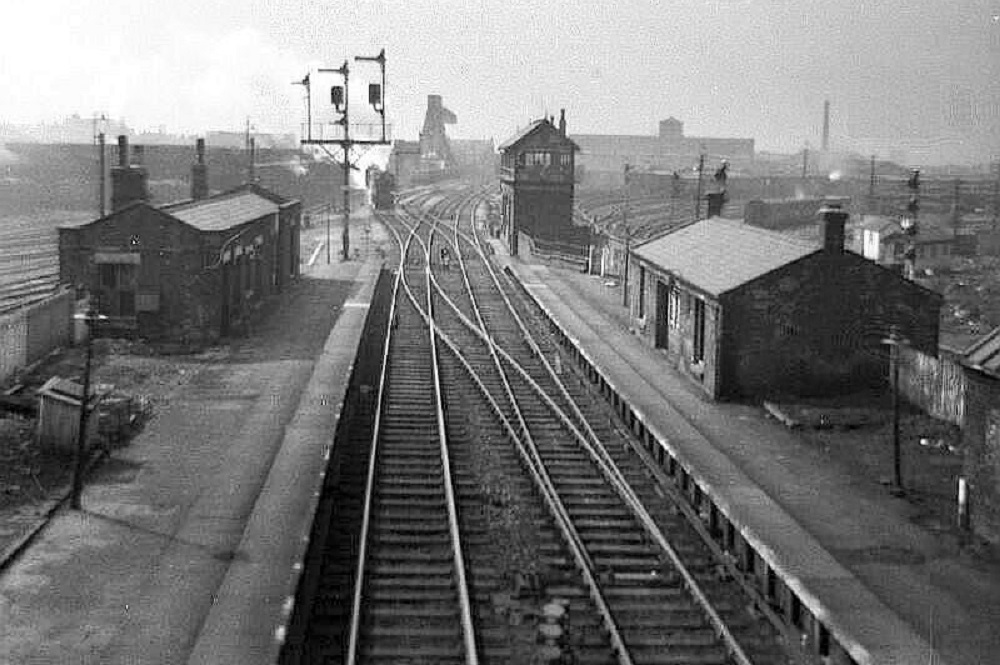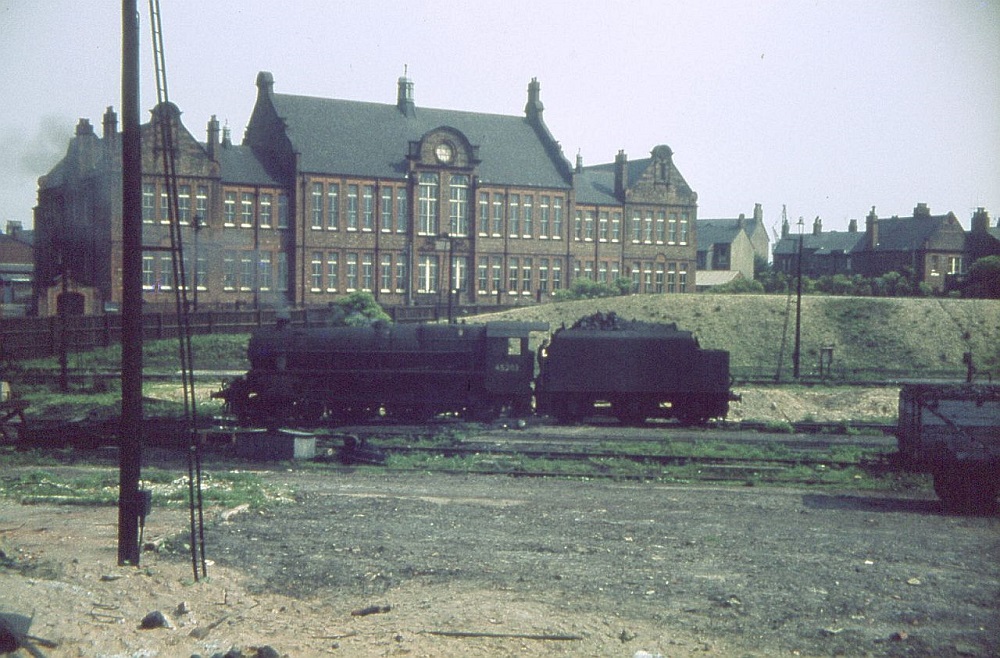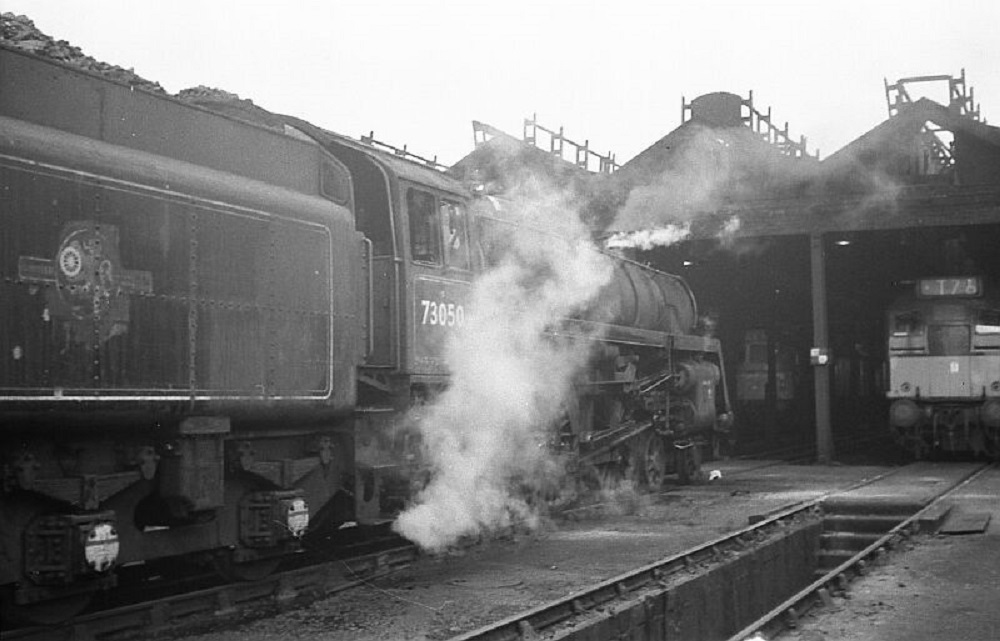If you took a bus or train to Newton Heath in the 1960s, your approaching stop would be signalled by a familiar landmark, visible from a good mile away: the huge concrete coaling tower at the railway sheds. Opened in 1876, this was by far the largest depot on the old Lancashire and Yorkshire Railway, stretching between Thorp Road and Dean Lane and lying between the lines to Rochdale and Oldham. Newton Heath locomotive depot in 1967, from the Thorp Road end, with the coal tower dominating the scene. St.Mary’s Road school can just be seen in the right background
Newton Heath locomotive depot in 1967, from the Thorp Road end, with the coal tower dominating the scene. St.Mary’s Road school can just be seen in the right background
The carriage works on North Road had opened the previous year, and in the 1890s extensive carriage sheds and sidings were added on the opposite side of the Rochdale line, completing a huge complex. Many of the houses off Lightbowne Road were built originally for railway workers.
The shed had 24 lines (‘roads’) inside, four of which formed a repair shop, nicknamed ‘the parlour’ by shed staff. At its peak, it accommodated over 200 engines. The coaling tower was added by the London Midland and Scottish Railway in 1935, the shed roof also being replaced. The north end of the yard was extended across Dean Lane, which originally ran beside the Railway Hotel and beneath Newton Heath station, and a new, larger, turntable added. The south-facing end of the buildings in July 1966; the half-width steam shed (left), with the diesel shed and refurbished repair shop on the right. The south-end turntable is in the foreground
The south-facing end of the buildings in July 1966; the half-width steam shed (left), with the diesel shed and refurbished repair shop on the right. The south-end turntable is in the foreground
Entrance to the station was diverted via paths running from St.Mary’s Road near the ‘hooped’ bridge and, to preserve the right of way towards Kenyon Lane, access was granted along the platform, over the footbridge and down steps near the signal-box, on to the continuation of Dean Lane (since filled in). A view towards Manchester from the footbridge at the original (1853) Newton Heath station on 30 March 1967. The steam shed is on the left, with the coaling tower in the distance, the carriage works beyond and the sidings to the right of the signal box. Today, only the tracks in the foreground remain – all else has gone. [Photo: S.P.Wilson]
A view towards Manchester from the footbridge at the original (1853) Newton Heath station on 30 March 1967. The steam shed is on the left, with the coaling tower in the distance, the carriage works beyond and the sidings to the right of the signal box. Today, only the tracks in the foreground remain – all else has gone. [Photo: S.P.Wilson]
By 1961, half the shed had been rebuilt to accommodate diesel units and the ‘parlour’ re-tracked, but there were still 140 steam and diesel locos based here for the many services, principally to the north, west and east of the country, as well as local trips. Besides the ‘home’ fleet, many engines from other areas often called in for servicing.
Like many others, I was a frequent visitor in the shed’s latter years, and it became a place to meet friends and observe the constant movement of locomotives in and around the yards, and trains passing on the adjacent lines. Even on winter nights, coal braziers, lit to keep the water columns from freezing, provided welcome warmth for huddled ‘spotters’ comparing notes.
The railway staff were generally very friendly and, if you showed a genuine interest, were only too happy to explain the workings of the equipment and engines (and, with luck, might let you drive one up to the turntable!). Close to the north-end turntable was another landmark: St.Mary’s Road School. Opened in 1869 as Newton Heath Wesleyan School, it became a Board school in 1903 and closed in 1968. A ‘Black 5’ loco backs off the north-end turntable in August 1967, with the school on the far side of St.Mary’s Road. How many lessons were disregarded, through gazing out of the windows? [Photo: S.P.Wilson]
A ‘Black 5’ loco backs off the north-end turntable in August 1967, with the school on the far side of St.Mary’s Road. How many lessons were disregarded, through gazing out of the windows? [Photo: S.P.Wilson]
The station was closed in December 1966 but not demolished until March 1968; the shed closed to steam on 30 June 1968, regular steam working in Britain ceasing altogether in August. For a while, a handful of withdrawn steamers languished, their fires dropped forever, awaiting a tow to a scrapyard: the last four went in October. However, on 8 September, the old shed dispatched one last steam visitor: no.73050 from Patricroft, which had been bought for £3,000 for preservation, and had come to Newton Heath for a final ‘fettling’ before making its way to the Nene Valley Railway at Peterborough. It is still running. 8 September 1968 and the shed hosts its last steam visitor, hissing at the diesels lurking within
8 September 1968 and the shed hosts its last steam visitor, hissing at the diesels lurking within
The steam buildings were demolished in March-April 1969 and the coaling tower in July; having defiantly withstood an attempt with gelignite, it leaned at a crazy angle for several weeks before finally succumbing. In 1971 the diesel shed was extended and a washing facility erected on the coal tower site, leaving the refurbished ‘parlour’ as the only part surviving from steam days.
Today the depot still services diesel units (rather fewer since Metrolink took over some local services), but is much reduced from its former busy, if sooty, glory.